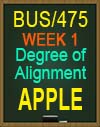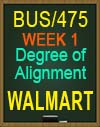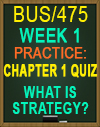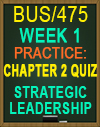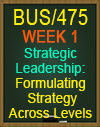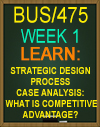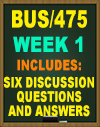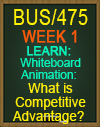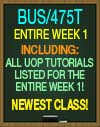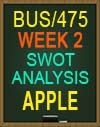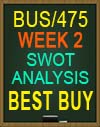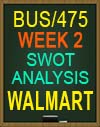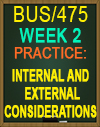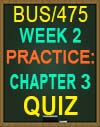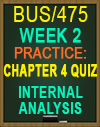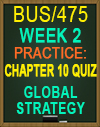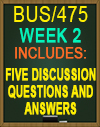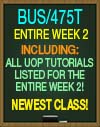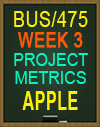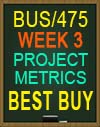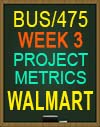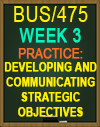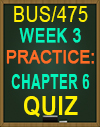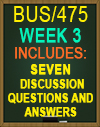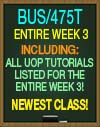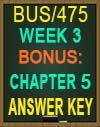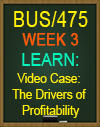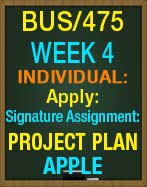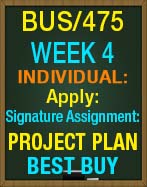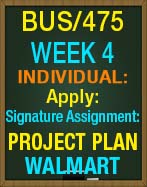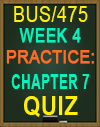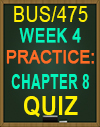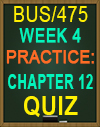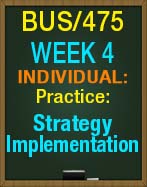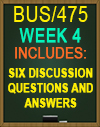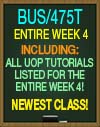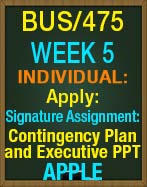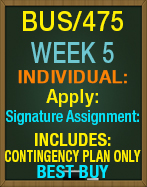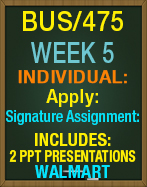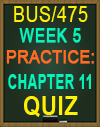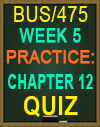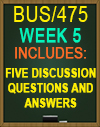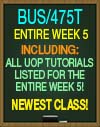BUS/475T Integrated Business Topics
|
 = To Purchase BUS/475T Entire Classwork (Included All Tutorials listed on this page). = To Purchase BUS/475T Entire Classwork (Included All Tutorials listed on this page).
|
|
|
|
|
|
|
|
|
|
|
|
BUS/475T Integrated Business Topics
Week 1
Week 1 Kit Includes:
1. Apply: Degree of Alignment (Includes Apple & Walmart)
2. Practice: Chapter 1 Quiz: What is Strategy
3. Practice: Chapter 2 Quiz: Strategic Leadership: Managing the Strategy Process
4. Practice: Strategic Leadership: Formulating Strategy Across Levels
5. Learn: The Strategic Design Process
6. Learn: Whiteboard Animation: What is Competitive Advantage?
7. Six Discussion Questions and Answers
BUS/475T WK1 Apply: Degree of Alignment
Includes Option #1
Includes Option #2
Resource: Degree of Alignment: Advanced Organizer Template
The assessments in this course give you the opportunity to design a project plan. Throughout the 5 weeks, you will choose an organization, create a project, write project metrics, and develop a plan that includes a contingency plan. You may use the course textbook and outside resources for all assessments.
This week you will choose your organization and learn about its corporate values. Review the 8 organizations listed in the case studies portion of the text.
Choose 1 of the organizations to use for all weekly assessments. You will not be able to change your organization, so ensure that you are comforatable with your choice.
An organization is typically centered on its mission and vision, but it may not always do as its statement says. Using the provided advanced organizer template, complete the following:
• List the information about the company
• Analyze the degree of alignment between what the organization is currently doing (actions) and their mission, vision, values, structure, and culture.
Cite all sources in APA format.
Submit the Wk 1 Apply: Degree of Alignment advanced organizer.
Strategic Leadership: Formulating Strategy Across Levels
PLEASE NOTE: Quiz questions are probably not in the same order, but they should all be there,
This activity focuses on IBM and how it uses corporate strategy, business strategy, and functional strategy to build competitive advantage. This activity is important because it illustrates how such strategies are created through the strategy process. The goal of this activity is to recognize at which levels of strategy key members of IBM act on behalf of the firm, and what questions they must ask to build competitive advantage.
Read the short case below and then complete the questions that follow.
This example is drawn from O’Reilly, C. A., B. Harreld, and M. Tushman (2009), “Organizational ambidexterity: IBM and emerging business opportunities,” California Management Review 51: 75–99
- For each manager, select the appropriate strategy to apply for “Level”; then select the appropriate question to ask for “Question”.
- According to the text, superior performance within the strategic business unit (SBU) is sought by asking which major question?
- Implementing the strategy is often overlooked by senior managers especially in large organizations. What level of manager is often responsible for making sure the strategy gets implemented in alignment with the corporate goals?
- The goal of this exercise is to identify the unique contributions of and benefits for different stakeholders. Match the contribution and benefit to its correct stakeholder.
- Successful business strategies generate value. Creating value lays the foundation for the important benefits that economies can provide. Superior performance allows the firm to
- Not all stakeholder groups are created equal. Their differential power can influence how economic value is both created and captured. As noted in the textbook, in the ________ industry, one of the most powerful external stakeholders has historically been unions.
- Match the category of social responsibility with the appropriate example.
- When Congress passed the Patient Protection and Affordable Care Act (PPACA), it created a (an) _______ responsibility for both individuals and firms of more than 50 people to carry health insurance.
- Managers must ensure that their firms obey all relevant laws, including labor, consumer, and environmental regulations. This is a firm’s __________ responsibility.
- Many companies incentivize employees through stock options (ESOPs). This practice allows employees to buy stock at discounted prices or use stock as a retirement investment. This has the effect of _______________.
Practice: Chapter 1 Quiz: What is Strategy?
PLEASE NOTE: Quiz questions are probably not in the same order, but they should all be there,
- Greener Grocers provides goods that are similar to competitor’s goods at a comparable price. Greener Grocers cannot lower prices more without facing financial difficulties. What is another way Greener Grocers could gain a competitive advantage?
- The element of a firm’s strategy that summarizes the ultimate goals of the firm is known as the _________________.
- Which of the following are primary strategy objectives? (Check all that apply.)
- Walmart and Nordstorm maintain very different strategic positions, one based on cost-leadership and the other based on differentiation through superior customer service. This is an example of ________________.
- Managers have ________________ resources in their quest for competitive advantage.
- Which of the following is an example of a strategy for competitive advantage?
- A(n) ___________ occurs when a firm performs below the industry average or is outperformed by its competitors.
- Michael’s Deli is able to perform at the same level as its primary competitor. Michael’s Deli has ______________________.
- Andrew’s Home Center has created a unique position for itself in its industry that allows the company to not only provide excellent value to its customer but also control its cost. This is known as _________________.
- Which of the following could accurately be called a strategy?
- Which of the following elements comprise strategic management? (Check all that apply.)
- In order to achieve and sustain competitive advantage, a company devises and adopts a set of goal-directed actions known collectively as a(n) _______.
- A good strategy consists of three elements. The second element is accomplished through strategy formulation, resulting in the firm’s functional, business-level and corporate-level strategies. This is also called __________________.
- A competitive advantage _____________.
- Burger Bomb has been outperforming other burger restaurants for a decade. This indicates that Burger Bomb has which of the following?
- Sustainable competitive advantage exists when a firm ______________.
- Which of the following are elements of a good strategy according to the AFI framework? (Check all that apply.)
- A good strategy consists of three elements. The first element is accomplished through analysis of the firm’s external and internal environments. We also call this __________________.
- A __________ (fill out one word only) outlines what an organization does, while a vision outlines what the organization wants to do.
- A(n) ___________ can help employees feel that they are doing something worthwhile and are part of something important and meaningful.
Practice: Chapter 2 Quiz: Strategic Leadership: Managing the Strategy Process
PLEASE NOTE: Quiz questions are probably not in the same order, but they should all be there,
- What structure is one of the most common types because it separates the specialized knowledge of each functional area through horizontal differentiation and can direct that knowledge toward the firm’s key products or services?
- In a firm, what determines who reports to whom?
- In the above case study, it states, “W.L. Gore & Associates… is organized in an informal and decentralized manner. It has no formal job titles, job descriptions, chains of command, formal communication channels, written rules or standard operating procedures.” If you were to “organize” the company using a standard hierarchy, how would you classify each position below? Match each answer to its corresponding responsibility.
- A matrix structure ___________.
- What is defined as, “the concern for proper communication enabling the units to understand one another’s activities.”
- Which departmentation structure groups individuals by skill, knowledge, and action yields?
- Managers must ensure that their firms obey all relevant laws, including labor, consumer, and environmental regulations. This is a firm’s _______ responsibility.
- A company’s strategic vision describes what?
- The stakeholders of a firm are _______.
- Which of the following are aims of stakeholder strategy?
- True or false: The strategist’s job is to focus on shareholders only.
- Which of the following is a tool that managers can use to address the needs of stakeholders while maintaining a competitive advantage?
- When a stakeholder has power over a company it is __________.
- Place the five steps of the stakeholder impact analysis in order, with the first step at the top.
- The concept, or framework, of corporate social __________ guides firms in identifying and addressing their economic, legal, ethical, and philanthropic obligations to society.
- Which of the following legal developments allow business to function as an institution? (check all that apply.)
- Starbuck’s commitment to fair trade and responsible growing practices indicates that the firm takes its ______ responsibilities seriously.
- The expectations that society has toward business, in contrast to what society requires, result in which of the following elements of the pyramid of corporate social responsibility? (Check all that apply.)
- Which of the following elements of the pyramid of corporate social responsibility are required by society? (Check all that apply.)
- Match the element of the pyramid of corporate social responsibility (on the left) with its explanation (on the right).
- _____-down strategic planning is a rational process through which executives attempt to program future success.
- A(n) ________ of control describes the tendency of managers to overestimate their ability to manage events.
- Both strategy formulation and strategy implementation are aspects of _________.
- A strategic business unit (SBU) is defined as a(n)__________.
- Place the progression of steps in the traditional top-down strategic planning in order, with the first step at the top.
- __________planning is a strategy-planning activity in which top management envisions various what-if scenarios to anticipate plausible futures in order to derive strategic responses.
- A(n)_____________ strategy is the outcome of a rational and structured, top-down strategic plan.
- Which of the following statements is correct?
- Which of the following are addressed during corporate strategy formulation?
- What are the approaches that can be utilized when strategizing for competitive advantage?
- True or false: Top-down strategic planning is most effective when the environment is constantly changing.
- The major assumption in the top-down strategic planning process is that ___________.
- A(n) ________ swan event is an unexpected and unlikely occurrence that has a significant impact on society.
- According to the book Good to Great by Jim Collins, companies that were able to gain a competitive edge all have what in common?
- A Level-____ (fill out a number) leader presents a convincing vision and mission that helps groups improve their performance.
- Rank the following levels of the level-5 leadership pyramid, placing the highest level at the top.
- A Level-____ leader is referred to as a contributing team member.
- What strategy addresses the question of how to compete?
- Functional strategy is primarily concerned with ___________.
- Which of the following are examples of black swan events?
- Which of the following are types of corporate social responsibilities that a firm may identify during the fourth step of stakeholder impact analysis? (Check all that apply.)
- According to upper-echelons theory, the way strategic leaders of a firm interpret a situation is influenced by which of the following?
- A firm that successfully executes a strategy benefits society by _______ (Check all that apply.)
- Among the various types of responsibilities a business firm has, which are specifically considered to be economic responsibilities? (Check all that apply.)
- For CEOs, what is an advantage of face-to-face meetings?
- Which of the following are outcomes of effective stakeholder management? (Check all that apply).
- Which of the following is NOT one of the variables used to determine whether the appropriate strategy process is strategic planning, scenario planning, or strategy as planned emergence?
- Which of the following is considered an internal stakeholder?
- What distinguishes a Level-5 leader from other levels of leaders?
- Which of the following statements are true about the views held by Sheryl Sandberg, one of the most influential women in the tech industry today? (Check all that apply.)
- In the second step of the stakeholder impact analysis, managers need to identify and understand stakeholders’ ___________.
- Research about how CEOs spend their days suggests that CEOs spend most of their time ________.
- Microsoft donating more than $3 billion in cash and software to people in need is an example of which type of corporate social responsibility?
- Sheryl Sandberg, named by Forbes magazine as the Most Powerful Woman in Tech for 2016, is the chief operating officer of ____________.
- ___________ allows for bottom-up strategic initiatives to occur within a company and to be reviewed by executives.
Learn: The Strategic Design Process
- What structure is one of the most common types because it separates the specialized knowledge of each functional area through horizontal differentiation and can direct that knowledge toward the firm’s key products or services?
- In a firm, what determines who reports to whom?
- In the above case study, it states, “W.L. Gore & Associates… is organized in an informal and decentralized manner. It has no formal job titles, job descriptions, chains of command, formal communication channels, written rules or standard operating procedures.” If you were to “organize” the company using a standard hierarchy, how would you classify each position below? Match each answer to its corresponding responsibility.
- A matrix structure ___________.
- What is defined as, “the concern for proper communication enabling the units to understand one another’s activities.”
- How do organizations define their purpose?
- Which departmentation structure groups individuals by skill, knowledge, and action yields?
- Managers must ensure that their firms obey all relevant laws, including labor, consumer, and environmental regulations. This is a firm’s _______ responsibility.
- A company’s strategic vision describes what?
Learn: Case Analysis: Whiteboard Animation: What is Competitive Advantage?
- Sustainable competitive advantage means a firm outperforms its peers over a sustained period of time. Such superior performance is noticed by the peer group that attempts to identify the source of the performance and copy it. This concept is called “benchmarking”. Which of the following demonstrates a benchmarking process?
Week 1: Discussion Question
Can an organization have a successful strategic plan without effective mission and vision statements? Why or why not?
Post your response in the discussion area.
Discussion Question: Mission and Vision Statements
How important is structure/culture compared to the other primary internal considerations for a strategic plan?
Discussion Question: Strategic Management
Includes 3 Separate Answers to this Discussion Question! A+ Work!
What is strategic management, what is its purpose, and why is it necessary? What are the components of a strategic plan? Which is most important? Why?
Discussion Question: Mission Statement and Your Organization
Includes 3 Separate Answers to this Discussion Question! A+ Work!
Locate the mission statement of the company you are using for your week 1 individual assignment. Where did you find it? Was it presented as a consolidated statement, or were you forced to assemble it yourself from various publications of the firm? Begin thinking about the mission statement you will develop for your new division (week 2 assignment). How will you ensure it is aligned?
Discussion Question: Organizational Culture
Includes 3 Separate Answers to this Discussion Question! A+ Work!
Three key activities (setting a direction, designing the organization, and nurturing a culture and ethics) are part of effective leaders' routinely activities. Explain how these 3 activities are inter-related.
Discussion Question: Values and Guiding Principles
Includes 3 Separate Answers to this Discussion Question! A+ Work!
What are values? How are they formed, developed, and possibly change over time? What values / guiding principles / behaviors will you expect from employees in your new division? (Hint: Feel free to use your response as part of your Week 2 individual assignment.) |
|
|
|
|
|
|
|
|
|
|
BUS/475T Integrated Business Topics
Week 2
Week 2 Kit Includes:
1. Apply: Signature Assignment: SWOT Analysis (includes 3 papers)
2. Practice: Chapter 3 Quiz: External Analysis
3. Practice: Chapter 4 Quiz: Internal Analysis: Resources, Capabilities, and Core Competencies
4. Practice: Chapter 10 Quiz: Global Strategy
5. Practice: Internal and External Considerations
6. Learn: Case Analysis: Whiteboard Animation: Porter’s Five Competitive Forces
7. Five Discussion Questions and Answers
Individual: SWOT Analysis
Includes Option #1 - Apple
Includes Option #2 - Best Buy
Includes Option #3 - Walmart
Resource: SWOT Analysis Template
Using the organization you selected for the Week 1 assignment, review its corporate website and at least 2 other sources of information on the organization, including information on market trends.
Complete a SWOT analysis from a global perspective, if applicable, using the SWOT analysis worksheet.
Complete a 2- to 3-page summary of your findings addressing the questions in the Analysis section of the worksheet.
Write a 525- to 700-word summary of your findings. Use information from the SWOT analysis as well as what you have learned about your business’s structure, culture, and interrelationships to write the summary. Your summary should:
- Explain how you would match the business’s strengths to its opportunities.
- Analyze how you would convert the business’s weaknesses into strengths.
- Explain the actions the business needs to take to advance its goals and/or expand its competitive advantage.
- Analyze interrelationships among distinct functional areas of the organization and how it may affect your SWOT analysis.
Cite all sources according to APA guidelines. Access the Reference & Citation Generator in the Center for Writing Excellence for citation assistance.
Submit your assignment.
Cite all sources following APA guidelines.
Submit your assignment.
Practice: Internal and External Considerations
Internal Analysis: Looking Inside the Firm of Honda Corp.
The strategic actions managers take link firm resources and capabilities. For example, investments in R&D labs (managerial actions) are one mechanism that links the resource (engineers) with the firm capability (product innovation). This activity is important because when multiple resources and capabilities are aligned on a single goal, the firm may have a core competency. For instance, Canon’s ability in optics originates not just in the capability of its design engineers, but also in its precision in manufacturing. When a firm’s core competency is at the heart of the product it sells, that product can be considered a core product. In the case of Canon, optics are at the heart of such products as cameras, camcorders, scanners, and projectors.
The goal of this activity is look closely at Honda, and differentiate the important relationships between its firm resources, managerial actions, firm capabilities, core competencies, and core products.
Read the case below and complete the activities that follow.
Practice: Chapter 3 Quiz: External Analysis
PLEASE NOTE: Quiz questions are probably not in the same order, but they should all be there,
- The most rigorous means of analyzing the profit potential within a specific industry is to conduct ___________.
- In general, a firm improves its strategic position by ____________.
- According to Porter’s model, which fo the following should be considered when analyzing a firm’s competition? (Check all that apply).
- The weaker the five forces in Porter’s model, the _________ the Industry’s profit potential.
- The power of __________ is the pressure they can put on the margins of producers in the industry by demanding a lower price or higher product quality.
- Which of the following tend to result from strong competitive rivalry?
- Which of the following statements is likely to be true about a fragmented industry?
- Many firms of all sizes actively compete in the computer hardware industry, and there are no firms with a large market share. Product offerings tend to be similar but are differentiated in ways that enable some firms to raise or impact pricing. The computer hardware industry is an example of ___________.
- In an oligopoly, which of the following conditions exist? (Check the three that apply).
- Which of the following is not a characteristic of industries that are monopolies?
- The online auction site eBay has more than 100 million active users, so buyers are more likely to find what they are looking for while sellers are more likely to find buyers for the items they are offering. This is an example of __________.
- Walmart producing private-label brands such as Equate health and beauty items and Parent’s choice baby products, is an example of _____________.
- When firms compete by offering unique product features rather than competing on price, ______ occurs.
- The key takeaway from the five forces model is that _____________.
- Advantages based on brand loyalty, proprietary technology, preferential access to raw materials, and
- favorable geographic locations are examples of _____________.
- The expected competitive intensity is stronger when the other four forces are _______, and weaker when the other four forces are _______.
- Governments sometimes set up a natural monopoly when a venture __________.
- Which of the following are likely outcomes of a competitive rivalry based entirely on price cutting? (Check all that apply).
- An industry analysis provides which of the following? (Check all that apply).
- When a firm is able to maximize the gap between _____, it increases its competitive advantage.
- Michael Porter developed the five forces model to help firms do which of the following? (Check all that apply).
- According to the five forces model, a firm seeking to compete in an established industry should seek to do which of the following? (Check all that apply).
- Production costs can increase when ___________.
- The pressure of rivalry increases when which of the following forces increase in intensity? (Check all that apply).
- Whick of the following are characteristics of a monopolistically competitive industry? (Check all that apply).
- The positive effect that one user of a product or service has on the value of that product or service for other users is know as the _______________.
- When a local company moves u9pstream in the industry value chain into his suppliers’ business, _______ occurs.
- True or false: The stronger the five forces, the greater the industry’s ability to earn above-average competitive advantage.
- Which of the following are advantages, independent of size, that incumbent firms possess? (Check all that apply).
- As utility companies tend to serve a whole market exclusively, they are known as ________ because the governments involved believe that the product or service would not be supplied otherwise.
- A group of companies that deal with more or less the same set of suppliers and buyers make up _______.
- A firm’s strategic position relates to its ability to create ________ for customers while containing the ________ to do so.
- According to Michael Porter, the profit potential of an industry is _________.
- Which of the following are ways in which the power of buyers affects producers? (Check all that apply).
- The intensity with which companies in an industry jockey for market share and profitability is known as ___________.
- The cultures, norms, and values of the society in which a firm competes are considered _______ factors.
- Recessions are less likely to harm ____-cost airlines, which appeal more to budget-conscious travelers than legacy carriers.
- Which of the following factors in a firm’s legal environment? (Check all that apply).
- In the group of external factors that form the PESTEL model, the “P” stand for _________ and the “L” stands for _________.
- Which of the following statements about industry dynamics is true? (Check all that apply).
- When companies seek ways to recharge car batteries in a sustainable way, it is an example of _____ factors creating business opportunities.
- True or false: Sociocultural factors tend to be fixed.
- A(n) ______ group is a set of companies within a specific industry that seek to achieve competitive advantage in similar ways.
- The NASDAQ peaked at its all-time high of 5,132 points on March 10, 2000. Hundreds of dot-com businesses were founded and funded during this time, but very few survived. This example shows that __________.
- It might be a good idea to expand or upgrade a firm’s human capital base during a _____ because unemployment is high and therefore human capital is abundant and wages usually ___________.
- The cultures, norms, and values of the society in which a firm competes are considered ______ factors.
- ESPN starting a Spanish-Language television channel called ESPN Deportes is an example of how companies react to the ___________ trend that the Hispanic population in the United States sees their income rising and is growing fast.
- Which of the following are examples of sociocultural factors? (Check all that apply).
- In the PESTEL model, political factors are those that relate to___________.
- Industry __________ is the process by which formerly unrelated industries begin to satisfy the same customer need.
- ________ factors result from the processes and actions of government bodies that influence the decisions and behavior of firms.
- Which of the following are important sources of entry barriers? (Check all that apply).
- The threat of entry is high when capital requirements are _________ in comparison to the expected returns.
- Exit barriers, strategic commitments, and competitive industry structure are important factors in determining the intensity of _____________ (fill out one word only).
- A ___________ occurs when a firm has accrued significant market power and is changing the industry structure in its favor.
- Rivalry among existing competitors has __________ with the height of the industry's exit barriers.
- When Samsung and Google cooperate as complementors to compete against Apple's strong position in the mobile device industry while at the same time becoming increasingly competitive with each other, this is referred to as ________________.
- If a business considers changing vendors, but doing so would require that business to alter products specifications, retrain employees, and/or modify existing processes, we would say the business faces significant_______________.
- Which of the following are examples of commonly encountered capital requirements? (Check all that apply).
- When there are a few buyers and each buyer purchases large quantities relative to the size of a single seller, the power of buyers is ______________.
- Exit barriers are composed of ______________ factors.
- When a person that has been using a PC with a Microsoft Windows operating system, starts using an Apple computer (which has a different operating system), she will incur significant customer ____________ costs. (Remember to enter only one word in the blank.)
- Which of the following helped Airbnb develop a successful business of peer-to-peer rental space? (Check all that apply),
- Industry-specific factors known as ________ separate one strategic group from another.
- In the airline industry, the _____________ (type in one word only) barriers of offering international routes restricts movement between hub-and-spoke and point-to-point airlines.
- Which of the following are approaches for answering the question "How to enter?" when a firm is considering entering an industry?
Practice: Chapter 4 Quiz
PLEASE NOTE: Quiz questions are probably not in the same order, but they should all be there,
- The organizational and managerial skills necessary to orchestrate a diverse set of resources and deploy them strategically are called ________________
- _________________ are the distinct and fine-grained business processes that enable firms to add incremental value by transforming inputs into goods and services.
- What should a firm do in order to be organized to capture value? (Check all that apply.)
- Which of the following is not considered an isolating mechanism?
- An early decision in the development of a firm, such as where the firm is established, can eventually have a major influence on final outcomes. This effect is referred to as ______________
- “Time compression is diseconomies” refers to the concept that _____________.
- Cowgirl Boots, inexpensive leather boots for women, are selling at record-high numbers. The CEO of the company, however, cannot figure out why. Was it caused by the company’s recent advertisement campaign or the newly reduced price of the boots or some other unknown factor? Based on this information, what concept describes the CEO’s confusion regarding Cowgirl Boots’ recent success?
- The culture of Zappos is hard to imitate because it consists of numerous, diverse interactions among its employees, processes, procedures and norms, that create which of the following?
- Which of the following are example of resource for a firm? (Check all that apply.)
- According to the resource-based view, firms are a distinctive collective of resources, capabilities and competencies.
- Which of the following is true according to the assumption of resource heterogeneity?
- What does the concept of resource immobility imply? (Check all that apply.)
- The _____________ is a theoretical model that explains and predicts what resource attributes underpin competitive advantage.
- A resource is considered _________________ if it helps a firm to deal with an external threat.
- What does the concept of resource heterogeneity imply?
- A core competency can help a company achieve which of the following? (Check all that apply.)
- The internal activities of a firm that for transforming inputs into outputs consists of primary activities, which add value directly, and support activities, which add value indirectly.
- _________________ activities add value directly by transforming inputs into outputs as the firm moves a product or service horizontally along the internal value chain.
- Accounting and finance are ____________activities in a firm’s value chain
- Which of the following are considered resources under the resource-based view of the firm? (Check all that apply.)
- Strategic fit _____________ the likelihood that a firm is able to gain a competitive advantage.
- The resource-based view classifies all resources as _____________.
- Which of the following can help a firm extend its competitive advantage? (Check all that apply.)
- ____________ is a framework that allows managers to synthesize insights obtained from internal and external analysis
- The _____________ perspective is a model that emphasizes a firm’s ability to modify and leverage its resource base in a way that enables it to sustain competitive advantage in a constantly changing environment.
- ________________describes firm’s ability to create, deploy, modify, reconfigure, upgrade or leverage its resources in its quest for competitive advantage.
- In which of the following ways did Dr.Dre build the coolness factor of Beats headphones as a core competency? (Check all that apply.)
- True or false: the value chain concept is applicable only to high-tech in rapidly changing environments.
- The _____________ describes the internal activities a firm engages in when transforming inputs into outputs.
- A firm trying to compete with the leading firm in a competitive industry can try to negate the leading firm’s competitive advantage through which of the following? (Check all that apply.)
- In a highly competitive industry, what are likely consequences of a firm’s neglecting its current
- The interaction of many individual systems in the operation of a company often leads to casual ambiguity because of _______________
- In which of the following ways did Apple stand to benefit from its 2014 acquisition of Dr. Dre’s Beats Electronics?
- Strong resource flows ____________________ a firm’s resource stocks.
- How are intangible resource stocks acquired?
- __________________ are the firm’s current level of intangible resources.
- According to the VRIO framework, in order for a firm to gain a temporary competitive advantage, a resource must be at least both ____________
- What can cause an outflow of intangible resource stocks from a firm? (Check all that apply.)
- In order to avoid making costly mistakes due to the potential shortcoming of the SWOT analysis, a manager should _______________
- One of the most popular tools by firms to evaluate their current situation and future prospects is the __________
- Capital, land, building and plants are example of___________resources.
- When strategizing about possible competitive advantages, a major advantage of the SWOT analysis is that it allows managers to simultaneously consider____________.
- Dynamic capabilities are most relevant in___________.
- In a firm’s resource valuable, rare, costly to imitate and the firm is organized to exploit it, this resource is a________
- ______________ has a greater chance of arising from intangible resources than from tangible resources.
- Using the “resource-based view” helps firm _______________.
- A firm’s culture, brand equity, and intellectual property are example of ____________-.
- ________ manifest themselves in superior products or services.
- While the ___________clarifies a firm’s core competencies, the_________ helps leaders understand how much competitive advantage arises from the firm’s unique activities.
- Better expectations of future resource value -------------- a firm’s competitive advantage.
Practice: Chapter 10 Quiz: Global Strategy
PLEASE NOTE: Quiz questions are probably not in the same order, but they should all be there,
- A company should only expand abroad if
- Benicio's Burritos is a leader in the Mexican fast-food category in the United States. It decides to expand internationally, starting in Japan. Benicio's Burritos fails within a year, learning later that Mexican food is uncommon in Japan and that the flavor profiles are not compatible with Japanese palates. The failure of Benicio's Burritos can be attributed to which of the following?
- Which of the following risks do companies face when expanding internationally?
- When a company has difficulty coordinating operations across geographic distance and between distinct culture environments, it experiences _______ .
- If the economic value creation of international expansion is negative, a firm should ______ .
- At a basic level, the concept of "liability of foreignness" refers to the additional _______ .
- MNEs pursuing a _______ ocean strategy tend to also pursue a transnational strategy.
- A(n) _________ strategy focuses on integration at the business level by attempting to reconcile product differentiations at low cost.
- The benefits to be accrued from locating value chain activities In the world’s optimal geographies for a specific activity are known as _________ economies.
- Which of the following characteristics help make an MNE's international strategy successful?
- What are the four quadrants of the integration-responsiveness framework?
- If a firm's goal is to leverage home-based core competencies in foreign markets, it should pursue a(n) strategy.
- The Japanese market is very particular, and MNEs tend to have a challenging time breaking into the market successfully. To provide the most local responsiveness and to influence Japanese consumers in believing that the products are local, an MNE should follow a(n)______ strategy.
- One notable advantage of a multidomestic strategy is
- Which of the following factors helped make Germany, which was a tough environment for a car company, conducive to successful car companies?
- When companies face a highly competitive environment at home, they are more likely to _______ .
- Which of the following statements about economic distance are true?
- As MNEs compete internationally, a focus on local responsiveness allows them to do which of the following?
- What are the factors in Michael Porter's model of national competitiveness?
- In order for a company to be considered a multinational enterprise, it must operate ______ .
- A company’s ________ is the part of a corporate strategy that addresses how to gain and sustain a competitive advantage when competing against other foreign and domestic companies around the world.
- Foreign direct investments are investments in ______ .
- True or false: U.S. MNEs have a disproportionately positive impact on the U.S. economy.
- Under Globalization 3.0, MNEs freely locate business functions anywhere in the world based on an optimal mix of which factors?
- Rising wages and other costs are likely to negate any benefits MNEs have of access to ________ .
- Which of the following statistics regarding MNEs are correct?
- Which of the following have helped make globalization possible?
- Which of the folloeing is the part of culture ?
- The extent to which members of a society feel anxious when faced with an unknown situation is known as
- The cultural disparity between the Internationally expanding firm's home country and its targeted host country is known as ________.
- In ______ societies, competitiveness, assertiveness, and the exercise of power are considered Ideal.
- The extent to which members of a society feel anxious when faced with an unknown situation is known as _______
- Which of the following dimensions are considered In the CAGE
- distance framework?
- Despite a growing belief In the death-of-distance hypothesis, there remains evidence that certain countries remain leaders in specific Industries and maintain a kind of ________ advantage.
- Companies seek to access international markets as a means of ______ .
- Which of the following are among the primary considerations when determining the mode in which a firm enters a foreign market?
- Calculating cultural distance involves comparing the cultures of which of the following?
- Which of the following have the effect of shrinking the administrative and political distance between countries?
- When a country's demand conditions include high-density urban living and high energy costs, consumers can be expected to prefer air conditioners that are which of the following?
- Which of the following are benefits of a transnational strategy?
- Since expanding internationally, IKEA has shifted focus, concentrating on effectively managing a global supply chain in order to achieve economies of scale. This is reflective of a(n) _________ strategy.
- The benefits of competing on a global scale exist _____.
- The strategic foundations of the globalization hypothesis are based primarily on _____ .
- Which of the following factors help define the administrative and political distance between two countries?
- the absence or presence of political hostilities
- During globalization 1.0 all Important business functions were located in the home country, whereas during globalization 2.0 multinationals began to copy themselves_______ .
- True or False: Though low-skilled laborers make much exists for high-skilled workers.
- Leading biotechnology, software, and Internet companies and leading computer concentrateo in wmen or tne following countries or states?
- A country’s natural, human, and other resources can be expressed in terms of_______.
- During the first stage of globalization, business functions that took place abroad were limited to which of the following?
- A multinational enterprise would likely be motivated to pursue a global-standardization strategy in order to ________ .
- In the global economy, according to Porter, competitive advantages increasingly exist in such as Silicon Valley.
- The belief that the importance of location is diminishing as an explanation of firm-level competitive advantage is called ________ .
- The oldest form of internationalization is __________, which involves producing goods in one country to sell in another country.
- When Walmart posted a list of banned suppliers on its website, this was an example of_________.
- In a global-standardization strategy, the main competitive element is ________ .
- Which of the following factors enabled India to gain a competitive advantage in business process outsourcing?
- Firms can achieve increased competitive advantage as a result of ________ , which are firms that
LEARN: Whiteboard Animation: Porter’s Five Competitive Forces
- According to the video, which of the following is true of price-based competition?
- According to the video, which of the following is an example of a buyer who will be able to successfully negotiate for lower prices?
- According to the video, which of the following is an example of a threat of substitute product or service?
Discussion Question: Internal & External Considerations
Do you think organizations differ from each other when placing importance on areas of the SWOT analysis?
Describe a real-world example of an organization that would place more importance on one area of the SWOT analysis compared to another area.
Discussion Question: Relationships/Partnerships: Extending the Supply Chain
While the focus of the video was on products, what about the service sector? How could you use supply chain to your benefit?
Discussion Question: Internal Assessment Factors
As it relates to internal assessment factors, typical factors to assess include strategy, structures, processes and systems, resources, goals, strategic capabilities, culture, technologies, innovation, intellectual property and leadership.? Class, of the above internal assessment factors, which do you see as having most importance for your new product or service? Please explain your selection.
Discussion Question: SWOT Analysis
What is SWOT analysis? What is its purpose in strategic planning? Must you conduct a SWOT analysis to have an effective strategic plan? Why or why not?
Discussion Question: Culture – Considerations in the Global Environment
Oftentimes, I believe, employees would be better served if management got out of their way and let them do the things they do best. Of course,
|
|
|
|
|
|
|
|
|
|
|
BUS/475T Integrated Business Topics
Week 3
Week 3 Kit Includes:
1. Apply: Project Metrics (includes 3 papers)
2. Practice: Chapter 6 Quiz: Business Strategy
3. BONUS Chapter 5 Answer Key
4. Practice: Developing and Communicating Strategic Objectives
5. Learn: Video Case: The Drivers of Profitability
6. Seven Discussion Questions
Apply: Project Metrics
Includes Option #1 - Best Buy
Includes Option #2 - Walmart
Includes Option #3 - Apple
Now that you've identified the organization's SWOT, you need to determine the project and its objectives and metrics. This project should be based on an unmet opportunity for the organization, or to minimize a potential threat. What does the organization need to do to advance its goals and/or expand its competitive advantage? How will you measure their progress?
Complete the following:
Explain why this opportunity/threat was selected, and how it is anticipated to benefit the organization.
Create at least 3 measurable project objectives based on your analyses.
Determine timelines and responsibilities for each objective (e.g. with a RACI chart)
Explain why these objectives are appropriate for the project.
Develop at least 2 metrics to evaluate achievement of each of the project objectives. Provide a 1-page explanation for why these are appropriate metrics for each of the objectives.
Cite all sources following APA guidelines.
Submit your assignment.
Practice: Developing and Communicating Strategic Objectives
PLEASE NOTE: Quiz questions are probably not in the same order, but they should all be there,
Economic Value Creation This activity is important because it reviews the concept of economic value creation when measuring competitive advantage. The goal of the activity is to learn how economic value creation helps a firm measure competitive advantage. Familiarize yourself with the text material from economic value creation before completing this exercise.
- The bar chart shown here provides the following information: cost to produce a pizza, price charged to the customer for the pizza, and the maximum price the consumer would be willing to pay for the pizza. Match each question to its correct cost response by clicking on each question and dragging it to the correct drop space beside each cost.
- ___________ denotes the dollar amount a consumer would attach to a good or service (that is, willingness to pay)
- Total costs include fixed and variable costs. _____________ costs are independent of consumer demand, whereas___________ costs change with the level of consumer demand.
- __________ costs capture the value of the _________ alternative use of the resources employed.
- Southwest and Delta both compete in the airline industry, but they follow different business strategies. Delta’s transportation infrastructure is based upon a high value hub-and-spoke system and offers upscale services to high mileage flyers. Southwest Airlines uses a point-to-point basic system for nationwide air transport. What generic business strategy is Southwest using?
- A strategic position is the firms profile based on value creation and cost. Effective managers will create a large gap between the __________ and the cost required to produce it.
- The four generic business strategies are generated by comparing the strategic position with the scope of competition. Tesla, an electric car manufacturer, is presented in the text as fitting into which of these categories?
- Timex and Rolex both compete in the wristwatch market, but they follow different business strategies. Rolex creates a high-quality timepiece with unique features that last a lifetime. Timex efficiently produces a watch of acceptable quality. What generic business strategy is Rolex using?
- Click and drag each business strategy listed on the left to its correct location above each stacked column in the relative (V-C) chart.
- A value innovation strategy requires trade-offs between differentiation and low costs. These are two distinct business-level positions that often require very different internal value chain activities. An example of a low-cost activity that may not be appropriate for a differentiator is
- A strategy canvas comparing JetBlue to the differentiated and low-cost airlines provides a visual depiction of some of the issues found in the JetBlue discussion throughout the chapter. Which three factors in the canvas (see Exhibit 6.11 in the text) most prominently show the key problems at JetBlue?
- Match each of the options above to the items below (market share, increased net profit, employee training, standard operational procedures)
- The text provides an example of a firm “stuck in the middle.” JCPenney attempted a change in strategic position under the leadership of CEO Ron Johnson (who was lured away from Apple retailing). Mr. Johnson was fired less than 18 months after his arrival at JCPenney due to a stark drop in sales after implementing some of his planned changes. What is a key lesson to be learned from this example?
- What is the following business goal missing? Increase sales by selling five more printers each month, selling them at local office supply stores.
- Identify the correct components of the SMART goals. Check all that apply.
- Which components of SMART is missing from this goal? “I will improve my grade in Science by the end of the semester”
Practice:. Chapter 5 Quiz - Answer Key included.
Practice: Ch. 6, Business Strategy
PLEASE NOTE: Quiz questions are probably not in the same order, but they should all be there,
- Products in the affordable “business-casual” clothing market have largely become commoditized, and most retailers have begun to compete mainly on price rather than product features. In this environment, it is impossible for one retailer to gain market share without another losing it. This is an example of a ____ _________ ocean.
- Which of the following are examples of ways that a large retailing firm can increase the perceived value of its offerings by focusing on customer service? (Check all that apply.)
- A tablet manufacturer that includes a free stylus with every purchase is using _____ to enhance users’ experiences and increase the perceived value of its tablets.
- Which of the following scenarios would result in strengthening a firm’s strategic position?
- Unique features and attributes that differentiate a product from competitors’ offerings allow the firm to________
- A manufacturer of electronic components can use its manufacturing machines to produce many different components such as semiconductors, sensors, and capacitors. In this case, the firm benefits from an economy of ______, reducing overall production costs by finding multiple uses for its components and facilities.
- Which of the following are questions that managers must answer when pursuing value innovation? (Check all that apply.)
- Furniture retailer IKEA has used the value innovation framework of _______ to successfully implement a blue ocean strategy.
- A firm’s strategic profile based on value creation and cost is called its __________.
- Which type of strategy is being used if a company offers a product at a lower cost than its competitors?
- High-end pen manufacturer Mont Blanc pursues a differentiation strategy with a(n) _______ scope of competition, pursuing only those who need or want an expensive writing instrument.
- Erosion of margins is a risk of both differentiation and cost-leadership business strategies for which competitive forces? (Check all that apply.)
- The benefits of a cost-leadership strategy regarding the threat of entry in an industry includes ________.
- The beneficial effect of a differentiation strategy on the power of suppliers in an industry is _______.
- The goal of a __________ strategy is to achieve costs below those of competitors while maintaining similar value. A firm with this strategy could or could not achieve differentiation parity.
- A firm’s competitive advantage is determined jointly by ______ effects and firm effects.
- In terms of business strategy, blue oceans represent which of the following? (Check all that apply.)
- Determining the products the customer wants and needs answers the _______ question of competition.
- Which of the following statements about a strong value curve are true? (Check all that apply.)
- A successful blue ocean strategy requires strategists to reconcile the trade-offs between
- Baby Buggy Baby sells high-end baby strollers. In an attempt to maintain its competitive advantage, the firm began adding additional features to its strollers. Customers liked these features and sales increased, but the company’s profit margins shrank. Which of the following is the likely reason for this?
- A producer of consumer headphones that successfully differentiates its products with a patented noice-cancelling technology and celebrity endorsements will enjoy which of the following benefits? (Check all that apply.)
- Which of the following are business strategies JetBlue pursued in order to gain a competitive advantage?
- Which of the following are input factors? (check all that apply.)
- Large output allows firms to invest in more specialist systems such as ______. (Check all that apply.)
- The cube-square rule makes it ______ for smaller stores to compete with larger retailers.
- An auto manufacturer that has access to cheaper labor and raw materials than its rivals will have a competitive advantage regarding lower cost of _______ factors.
- Which of the following situations would justify the use of manufacturing robots by a producer of packaged foods?
- Which of the following are sidnificant threats to a firm pursuing a cost-leadership strategy? (Check all that apply.)
- Which of the following are pricing options offered by a blue ocean strategy? (Check all that apply.)
- Which of the following accurately describes the relationship between value and cost that would suggest that firm A has created a competitive advantage over firm B?
- A(n) _______ strategy attempts to increase the perceived value of a product while controlling costs.
- A firm pursuing a blue ocean strategy can increase its profit margins by implementing which of the following pricing options? (check all that apply.)
- Which of the following best exemplifies a company that successfully uses a differentiation strategy?
- As JetBlue grew, which of the following occurred during the years following 2007?
- The most significant challenge JetBlue faced in implementing its business strategy was ______.
- Patti’s Potato Chips is a national potato-chip manufacturer. Calpurnia’s Crisps is a small-batch gourmet potato-check maker. Based on just this information, which of the following is the greatest advantage Pattie’s has over Calpurnia’s?
- A company with a cost-leadership strategy faces significant difficulties when ______.
- When pursuing a differentiation strategy, a firm can achieve a competitive advantage by_________.
Learn: Video Case: The Drivers of Profitability
3 questions and answers included.
Week 3 Discussion Questions
Discussion Question: Strategic Objectives
What are strategic objectives? What is the purpose of strategic objectives? What makes a strategic objective effective? What are examples of strategic objectives for your organization or one with which you are familiar?
Discussion Question: Three Generic Strategies
Briefly describe the three generic strategies - overall cost leadership, differentiation, and focus. Which strategy is the best fit for your new division?
Discussion Question: Shareholder Value
Discuss some of the actions that managers may engage in to erode shareholder value. As the manager of your new division, how will you prevent these occurrences?
Discussion Question: Value Creation and Diversification
Discuss how managers can create value for their firm through diversification efforts.
Discussion Question: International Market Expansion
What are some of the advantages and disadvantages associated with a firm's expansion into international markets?
Discussion Question: Expansion Strategies
There are four basic strategies - international, global, multidomestic, and transnational. What are the advantages and disadvantages associated with each?
|
|
|
|
|
|
|
|
|
|
|
BUS/475T Integrated Business Topics
Week 4
Week 4 Kit Includes:
1. Apply: Signature Assignment: Project Plan (Includes 3 papers for Walmart, Best Buy, and Apple)
2. Practice: Chapter 7 Quiz: Business Strategy: Innovation, Entrepreneurship, and Platformss
3. Practice: Chapter 8 Quiz: Corporate Strategy: Vertical Integration and Diversification
4. Practice: Chapter 12 Quiz: Corporate Governance and Business Ethics
5. Practice: Strategy Implementation
6. Six: Discussion Questions
Apply: Signature Assignment: Project Plan
Resource: Project Plan Template
A project plan is based on research and organizational goals. To see an exemplar project plan, review the Project Plan Example. Use the Project Plan Template and the business needs identified in your Week 3 Balanced Scorecard to:
o Develop the project objectives.
o Explain what operational steps will be taken to achieve your stated objectives.
o Identify the responsible person(s) for each operational step.
o Outline a timeline for each operational step. Justify the choices you made in your project plan in a 525- to
700-word response on the Project Plan Template.
Note: Review Strategic Management-8 Most Popular Cases in Connect. Access the case studies from the folder on the main course page in Blackboard.
Cite any sources according to APA guidelines.
Submit your assignment.
Practice: Strategy Implementation
- Read again the definition of the platform business model in the overview. Then complete each statement with the term that correctly defines each platform strategy advantage. Note: Not all terms are used.
- Move the corresponding statements about the corporate diversification components to the correct position in the list.
- The relationship between the type of diversification and overall firm performance
- The selling of Busch Entertainment, a theme park unit that owns SeaWorld, by Belgium-based AB InBev after the acquisition of Anheuser-Busch by InBev to ensure a focus on AB InBev’s core business, is an example of
- Which section of the project management plan describes how to monitor project progress and handle changes?
- Strategic business units that compete in a low-growth market but hold considerable market share are called _________. Their earnings and cash flows are high and stable.
- Match each company to the type of innovation for which it is known.
- Suppose that a company has successfully used architectural innovation to reconfigure a product and is now the market leader. In order to improve its product offering, extend the time that it can extract profits from its products, and maintain high entry barriers for new rivals, it will most likely engage in __________ innovation next.
- GE is disrupting itself by using reverse innovation to create low-cost health care diagnostic products in emerging markets (refer to Strategy Highlight 7.2 in the text). All of the following are true about this strategy except
- All of the following are strategies an established firm can adopt in order to protect itself from disruptive innovation by rivals except
- The ultimate goal of _______ is to create a realistic project timeline that provides a basis for monitoring project progress for the time dimension of the project.
Practice: Chapter 7: Business Strategy: Innovation, Entrepreneurship, and Platforms
PLEASE NOTE: Quiz questions are probably not in the same order, but they should all be there,
- Taking on an economic risk in order to innovate is known as --------------------.
- People who pursue entrepreneurship within an existing company are called------------.
- Which of the following types of entrepreneurship involves leveraging innovation for competitive advantage?
- True or false: Industries often tend to follow a predictable industry life cycle.
- Which characteristics always change as the industry life cycle progresses? (Check all that apply.)
- A firm that successfully leverages network effects can------------.
- During the growth stage of the industry life cycle, --------- increases rapidly.
- An agreed-upon solution about a common set of engineering features and design choice is known as a--------------.
- During the shakeout stage of the industry life cycle, profits degrade for-----------.
- In the ------------- stage of the industry life cycle, a few number of large firms compete for a share of the market that has reached maximum size.
- Demand declines most rapidly in the ------------- stage of the industry life cycle.
- Which of the following are strategic options in the stage of the industry life cycle? (Check all that apply.)
- It is challenging for firms “cross the chasm” because------------.
- A signification between technology enthusiasts and adopters is that --------------------.
- Which of the following are characteristics of the early majority? (Check all that apply.)
- Which two customer segment make up the largest percentage of the market potential? (Check all that apply.)
- Most firms consider laggards to be --------------.
- An innovation that targets existing markets with new technologies, is called a(n) ------------- innovation.
- Because it targeted a new market and used new technologies, the first mass-produced automobile is considered a(n)-------------- innovation.
- The invention of small desktop copiers to create a new consumer market using the same technology as large, stand-alone copiers is an example of a(n) ------------- innovation.
- Netflix was able to attract subscribers and grow largely because -------------.
- The customer segment knows as the early majority tends to enter the market --------------.
- When a company introduces a new product or process or business model with the intent of gaining a competitive advantage, that company is engaging in ----------------.
- Which the following allows a firms to redefine a market in its favor?
- Attempting to address social or ecological issue when building a for-profit business is known as --------------.
- During the introductory stage of the industry life cycle, innovators will likely devote most of their time, money, and effort to -------------.
- First –mover disadvantages can include which of the following? (Check all that apply.)
- When Apple launched the iPhone, it quickly became popular because many companies create apps that worked exclusively on the iPhone. Which of the following did Apple leverage to create a competitive advantage?
- During the growth stage of the industry life cycle, firms focus on process innovation in order to ------------. (Check all that apply.)
- Establishing a solid strategic position that competitors cannot easily imitate is the key objective of a company in the --------------- stage.
- During the shakeout stage of the industry life cycle, process innovation-------------.
- True or false: The chasm separating the early adopters from the early majority is the largest.
- Which is the most common customer segment in the introductory stage of the industry life cycle?
- Place the S- curve development of most industries in order, with the first step at the top.
- In which stage of the industry life cycle does competition become more intense, forcing weaker firms out the industry?
- The most common type of innovation is ------------ innovation.
- Which type of innovation uses new technologies to invade an existing market from the bottom up?
- Which of the following is a primary factor in avoiding creative destruction?
- Which of the following is an example of creative destruction?
- Which are the four steps of the innovation process?
- Which of the following is an example of invention?
- The ---------- determines whether an invention can be patented.
- A patent holder typically has a ----------.
- The commercialization of an invention by entrepreneurs is called ---------------.
- The process by which word-processor manufacturer Wang L aboratories captured the market from typewriter manufacturers, and which explain how it was later replace by PC manufacture and mobile-phone companies, is known as ----------.
- A form of intellectual property that grants an inventor a temporary monopoly on a new product or process in exchange for disclosing the details of how the product or process is made is called a(n) -----------.
- Match the type of innovation (on the left) with an example (on the right).
Practice: Chapter 8 Quiz: Corporate Strategy: Vertical Integration and Diversification
PLEASE NOTE: Quiz questions are probably not in the same order, but they should all be there,
- A firm that is active in several different countries is pursuing a(n) ----------------diversification strategy.
- To figure out if a firm’s type of diversification is -------------, one can ask question about the degree to which the corporation’s business units share core competencies.
- True or false: A major reason why a firm may choose a related diversification strategy is to take advantage of both economies of scale and scope.
- In the -------------- quadrant of the core competence—market matrix, a film combines existing core competencies with existing markets.
- A(n) ---------- is a situation in which the stock price of a highly diversified firms is valued as less than the sum of their individual business units.
- The Boston Consulting Group growth—share matrix locates a firm’s individual SBU in which of the following dimensions? (Check all that apply.)
- In the ------------- quadrant of the core competence—market matrix, the focus is on leveraging current core competencies to improve current market position.
- What are the four quadrants of the core competence—market matrix? (Check all that apply.)
- When engaging in short—term contracting, a firm sends out to potential companies which initiate competitive bidding for contracts to be awarded with a short during.
- Which of the following are types of strategic alliances? (Check all that apply.)
- Long—term contracts typically last ----------.
- Long—term contracts include which of the following forms? (Check all that apply.)
- ------------- are partnerships in which at least one partner takes ownership in the other partner.
- Kava Botanicals, a boutique retailer that high—end makeup and accessories, is owned by two makeup manufacturers. Kava Botanicals is an example of which type of strategic alliance?
- The forms of specialized assets include which of the following? (Check all that apply.)
- Which of the following are the four underlying strategic management concepts that detetrmine the scope of a firm? (Check all that apply.)
- Which of the following is the best option to take if you are the buyer and facing information asymmetry?
- The two alternatives to vertical integration are which of the following? (Select all that apply.)
- A state university hires an outside firm to develop and maintain their human resource system. This is called -------------------.
- ----------- refers to an increase in the variety of products and services a firm offers or markets and the geographic regions in which it compete.
- Which of the following are alternatives on the make—or—continuum? (Check all that apply.)
- Which of the following are among the reasons firms need to grow? (Check all that apply.)
- Which of the following are type vertical integration along the industry value chaine? (Check all that apply.)
- Specialized assets have ------------.
- When a business answers the question of where to complete, it is determing--------------.
- One way to overcome the principle—agent problem is to -------------.
- --------------- is a situation in which one party has more knowledge than another due to the possession of private knowledge.
- Each stage of the vertical value chain represents a distinct --------------- in which a number of different firms are competing.
- Stage four and five of the industry value chain involve ------------------. (Check all that apply.)
- Olivia’s, an olive oil company, grows and harvests olives, makes olive oil , and distributes its olive oil to its retail shop. Olivia’s is an example of ------------------.
- Advantages of vertical integration include which of the following? (Check all that apply.)
- What are the risks of vertical integration? (Check all that apply.)
- ------------- is a way of orchestrating value activities in which a firm is backwardly or forwardly integrates and relies on outside—market firma for supplies or distribution.
- Taper integration allows firms to -------------. (Check all that apply.)
- In a fully vertically integrated organization, ----------------.
- The risks of vehicle integrate are increased costs, reduced quality, reduced flexibility, and ----------------.
- Transaction cost include --------------- costs associated with an economical exchange.
- When a firm is more efficient in organizing economic activity than markets are, the firm should -----------------.
- What are advantage of organizing economic activity inside of a firm? (Check all that apply.)
- Disadvantages of organizing economic activity in the open market include all of the following except ------------.
- Why did Coca-Cola enter into a strategic alliance with Monster?
- Wheels on the Go! Is a company that manufactures tires for semitrucks. The company is entirely owned by North American Haulers, a large company in the semitruck industry. The two companies have formed a(n) -----------------.
- Google’s choice to hire programmers in—house suggest that they decided that the ----------------- Costs associated with this strategy are---------------- than the costs associated with contracting in the open market.
- ------------- are perhaps the major drawback of transacting in markets.
- What type of arrangement did Coca—Cola form with Monster in 2014?
- Advantage of organizing economic activity at the market level include which of the following?
- Which types of diversification tend to have the lowest performance? (Check all that apply.)
- In order to assess whether ----------is working, managers can ask if the individual businesses are worth more under the firm’s management or if they are worth more under individual management.
- According to the Boston Consulting Group matrix, cash cows are SBUs that do which of the following?
- What are the costs associated with related—diversification strategies? (Check all that apply.)
- In the Boston Consulting Group matrix, -------------hold the small market share in low-growth market.
- In general, related diversification leads to high level of performance because ----------------.
- Corporate strategy needs to be dynamic over time in order to ----------. (Check all that apply,)
- In general, related diversification leads to high levels of performance because ------------------.
- What are the three dimensions along which executives formulate corporate strategy?
- “Which national markets should the firm compete in ?” is an example of a ----------------- level strategic question.
Practice: Ch. 12, Corporate Governance and Business Ethics
- High – profit accounting scandals and the global financial crisis are example of -----------------.
- True or false: Any action taken by a manager that is within the bounds of the is, by definition, an ethics action.
- Which of the following have been found to be ethics normal in business? (Check all that apply.)
- When facing an ethics dilemma, a manager should -------------. (Check all that apply.)
Discussion Question: Spotlight Strategy
As it relates to strategy, you might find this (spotlight strategy 1.2) particularly interesting. It has relevance, I believe, for any organization, as it described being alert and taking time to recognize any opportunities beyond the confines of one's job.
Discussion Question: Leadership Characteristics
Class, seven attributes that enable good leadership have been described--vision, performance, principles, education of subordinates, perseverance, passion, and leader selection/development. Which one have you found to be the most meaningful to you in the leaders you respond to the best?
Discussion Question: Communications and Strategic Plan
Class, has your current (or former) organization's strategic plan been communicated to you? If so, how and by whom? If not, how would such communication improve your organizational effectiveness? Is it important for employees to know the strategic plan of a company? Why or why not?
Discussion Question: Fostering Innovation
Class, considering products where the life cycle is nearing an end, having a pipeline of innovative, new products and services may be critical to organizational viability.
All, does your organization (or one you are familiar with) have an environment that supports perceived opportunities and allows one to fail? Please explain
Discussion Question: Performance Management Systems and Process
Class, the speaker in this video has many years of experience in implementing and assessing performance management systems.
All, considering the performance management system in place at your current (or former) employer, do you believe the system is effective? Why/why not?
|
|
|
|
|
|
|
|
|
|
|
BUS/475T Integrated Business Topics
Week 5
Week 5 Kit Includes:
1. Apply: Signature Assignment: Contingency Plan and Executive Presentation
2. Practice: Chapter 11 Quiz: Organizational Design: Structure, Culture, and Control
3. Practice: Chapter 12 Quiz: Corporate Governance and Business Ethics
4. Practice: Organizational Design
5. Five Discussion Questions
Apply: Signature Assignment: Contingency Plan and Executive Presentation
APPLY - Includes Contingency Plan and 2 Full PowerPoint Presentations
BEST BUY - Includes Contingency Plan only
WALMART - Includes 2 Full PowerPoint Presentations
Project plans outline the intended course of events; however, things don't always happen as intended. Organizations need to consider risks and develop a contingency plan. This plan is typically presented to management.
Add the following 2 columns to the project plan table you created in Wk 4 - Apply: Project Plan:
1. Potential Risk Factors
2. Contingency Plans
Based on your prior research, determine potential risk factors for not meeting each of the project objectives. Develop a contingency plan for each of the potential risks. Add the potential risks and contingency plan to your Wk 4 - Apply: Project Plan.
Use Microsoft PowerPoint, Prezi, or another software to create a 12- to 14-slide executive presentation - with appropriate images and diagrams - that summarizes the following information:
1. The organization's information presented in Wk 1
2. SWOT analysis and market trend research
3. Project objectives
4. How success will be measured.
5. The value this project will bring to the organization
6. Project metrics
7. Timelines
8. Responsible parties
9. Potential risk factors
10. Contingency plans
Include detailed speaker notes within the presentation. Convert the speaker notes to a Microsoft Word document and add it to the citations slide.
Cite all sources according to APA gudelines.
You will submit 2 different deliverables:
1. Updated project plan with potential risk factors and a contingency plan
2. Executive presentation with detailed speaker notes as a Word document.
Practice: Organizational Design
PLEASE NOTE: Quiz questions are probably not in the same order, but they should all be there,
- As discussed in the case and the text, W.L. Gore and Zappos adopted new organization structures during periods of growth. In general, most firms follow a predictable pattern of structural change. Which of the following best exemplifies this pattern?
- As discussed in the case, W.L. Gore eventually adopted a cooperative multidivisional organizational structure. Which of the following is not a reason why this type of structure is advantageous for firms like W.L. Gore?
- Suppose that a small company makes a standardized product is experiencing an increase in sales even though it has a small geographic footprint. Currently the founder makes all the strategic decisions but is beginning to feel overwhelmed. She has decided to pursue a cost-leadership strategy going forward. In order for the firm to achieve its goals, which of the following business-level structures should the firm adopt?
- Which of the following scenarios would justify a firm using an organizational structure that supports centralized decision making?
- Concerning strategy and organizational structure, which of the following is false?
- Topic: Organizing for Competitive Advantage. You have learned from your training materials that organizational design is the process of creating, implementing, monitoring, and modifying the structure, processes, and procedures of an organization. Refer to pages 1-3 of HPs 2014 Annual Report. This report shows evidence of a focus on reorganizing for competitive advantage. True or False.
- Topic: Organizing for Competitive Advantage. Reference page 4 of HP’s 2014 Annual Report. What aspect of organizational design is suggested in the “Separation” section?
- Topic: Organizing for Competitive Advantage. HP has an organic organization. True or False.
- Reference the “Executive Office” section on pages 15-17 of HP’s 2014 10-K statement. Leverage your knowledge about functional structures to determine which of the following executives are likely to have been organized to maximize their domain effectiveness as it relates to the value chain. Check all that apply.
- Reflect on your answer to the previous question. HP is considering initiating a “new employee handbook” that helps explain the benefits of this form of organizational structure. You have been assigned to write a brief introduction for this handbook…so, what benefits does this structure provide? Refer to your training handbook for guidance on this question. Check all that apply.
- Topic Functional Structure. Reference the “Executive Officer” section on pages 15-17 of HP’s 2014 10-K statement. Which executive on this list is most likely the leader of HP’s organizational functions?
- Reference the “Note 2: Segment Information” section on pages 99-105 of HP’s 2014 10-K statement. Of the segments around which HP’s operations are organized for financial reporting purposes, which one is not actually a reportable segment?
- For the divisions of HP that have P&L responsibility, what structure has the capability to leverage the functional organizations in a way that combines economies of scale and efficient processing of information with organizational responsiveness and a decentralized focus?
- You have learned from your training materials that values and norms contribute directly to a company’s culture. Culture, defined as shared norms, in turn contributes to control by helping employees address unpredictable and irregular situations and problems (common in service businesses). HP believe it has a risk regarding its proper management of service businesses. HP plans to contact SMI this week to discuss potential organizational cultural mitigations that HP could put in place to help ensure that their employees pay special attention to customer service. Which of the following could be included in a list of recommendations that focus on the expression of organizational culture? Check all that apply.
- Assume one of the SWOT findings was an internal weakness of low motivation in the sales force regarding product sales. HP has designed a new compensation system to address this motivation. In which stage of the strategy implementation framework does this action reside?
Practice: Chapter 11 Quiz: Organizational Design: Structure, Culture, and Control
PLEASE NOTE: Quiz questions are probably not in the same order, but they should all be there,
- What is the main reason why boards of directors fire CEOs?
- A firm’s unwillingness to alter how things are currently done is known as
- Hiroshi is considering a job offer from a large pharmaceutical company. At his interview he asks who his boss would be and how jobs and teams are assigned. Hiroshi is asking about the company’s _____.
- The element of organizational structure that separates the tasks of one job from the tasks of another is known as
- The Foamy Mug, a chain of coffee shops, ensures consistent quality and service in each of its cafés by using policy and procedure manuals that explicitly describe employee tasks. The Foamy Mug is characterized by a high degree of
- Which of the following tends to result in delayed response time and lower customer satisfaction?
- If there are several levels of management between the lowest employee and the CEO, the firr has ________structure.
- Mechanistic organizations tend to have__________.
- Which of the following are frequently associated with organic organizations?
- Simple structures tend to be used by which group?
- What are two internal governance mechanisms put in place to align principal and agent incentives?
- Which type of structure uses domain expertise to separate employees into specific areas based on their purpose, such as sales and human resources?
- What is the goal of a differentiation strategy?
- Which of the following terms describes applying current knowledge to enhance firm performance in the short term?
- Which of the following structures is divided into several distinct business units, each of which has its own profit-and-loss center?
- True or false: Firms that pursue either related or unrelated diversification generally employ a multidivisional structure.
- Which of the following are benefits of a functional structure that also apply to the matrix structure?
- A firm using a(n) ___________ strategy is likely to have a multidivisional structure with the multiple divisions representing different geographic areas and decentralized decision making.
- A characteristic of a matrix organizational structure is that it _______ .
- Taki works for a start-up company that is highly centralized and its employees are not allowed to wear headphones while working. However, the company offers a flexible work schedule, free childcare, and free yoga classes. These rules and perks describe the company's_______.
- Which of the following are examples of artifacts of an organization's culture?
- Which of the following is the most observable element of organizational culture?
- How do founders leave their imprint on their organizations?
- Which of the following defines who reports to whom?
- Which two of the following accurately describe mechanistic organizations?
- Which type of the organizational structure and employs decentralized decision making?
- Which of the following terms describe searching for new knowledge that may enhance a firm's future performance?
- A firm would use input controls if
- Strategy implementation is essentially _________ .
- Which of the following are factors that influenced the shift from closed innovation to open innovation?
- Which of the following did Zappos choose as its primary core value?
- Which of the following is a situation in which individuals follow a leader without challenging or critically evaluating the leader's ideas?
- The primary way cultural change is enacted in a company is through
- If a company fails to change its culture as the firm and environment change, the company's culture can turn into a core_________ .
- How does an organization's culture influence employee behavior?
- When causal relationships among values, norms, artifacts, and the firm's performance are hard to establish, making it difficult to imitate a firm's culture, the culture is characterized by___________.
- Which of the following statements about closed innovation are true?
- During the 20th century, companies tended to carry out R&D internally, an approach known as_______.
- Which three key levers con managers use when shaping their organization Into a firm with the highest level of competitive advantage?
- Which of the following statements are true of the network organizational structure?
- Which of the following are examples of input controls?
- Which of the following statements are true of the network organizational structure?
- When a firm's employees have internalized norms and share the firm's core values, the firm is said to have a(n)_____________culture.
- Which of the following types of control defines expected results in order to guide employee behavior?
- Motivation that is driven by the employee's interest and the meaning of the work itself is called _____________ motivation.
- When the span of control within an organization is wide, one manager supervises
- The organizational structure at Gore may be described as
- Zappos is the only large company organized as a holacracy. What does this say about Zappos?
Practice: Chapter 12 Quiz. Corporate Governance and Business Ethics
PLEASE NOTE: Quiz questions are probably not in the same order, but they should all be there,
- An executive can legally earn a significant profit from stock options if _______.
- The ratio of CEO to average employee pay in the United States is about _______ .
- Incentives that are too high-powered, such as an outsized bonus, may cause individuals to _______ .
- If a company is poorly managed, its stock price may fall low enough for the firm to become a target for a(n)_________ .
- Following the rise of institutional investors, the use of poison pills to avoid hostile takeover has ________ .
- Financial statements by public companies must _______ .
- The relationship between CEO pay and job performance has been shown to be ______ .
- Which of the following is a federal regulatory agency whose task it is to oversee stock trading and enforce federal securities laws?
- In order to reconcile economic and social needs within the shared value creation network, managers need to focus on ________ .
- What are the four characteristics of a public stock company that make it an attractive corporate form?
- Narrowly defining public stock companies in terms of financial performance can lead to _______
- Optics Incorporated, a publicly traded eyewear business, places profits ahead of all other performance metrics. This practice ______.
- In comparison to other countries, the United States ranks ________ in terms of its acceptance of Milton Friedman's philosophy that "the social responsibility of business is to increase its profits."
- The shared value creation framework encourages managers to focus on which of the following needs?
- The idea of corporate social responsibility (CSR) suggests that a firm's obligations should _______ .
- The ideas of corporate social responsibility and stakeholder strategy are particularly prevalent in __________ .
- A board of directors is elected to represent the interests of
- Which of the following is an example of an application of agency theory?
- The hiring of a job seeker who claims to have extensive computer programming experience when his knowledge of the subject is minimal would be an example of _______ .
- Which of the following are examples of moral hazard?
Discussion Question: Wage Rate and Quantity of Labor
Discuss how competitive markets determine the wage rate and the quantity of labor that should be employed.
Discussion Question: Just for Fun – Part 1
If you could meet any business leader in the world, from any time period, whom would you select? Why would you want to meet this person? What questions would you ask him/her? What could this person teach us that would be helpful today?
Discussion Question: Just for Fun – Part 2
Knowing that strategic planning is the ability to evaluate the past, understand the present, and predict the future, which one do you think most executives have more trouble with: evaluating the past, understanding the present or predicting the future? Why?
Discussion Question: Communications and Strategic Plan
Describe traditional control systems and contemporary control systems. What are the main differences between these two systems? What are the main advantages of the contemporary control system over traditional?
Discussion Question: Strategic Decision-Making
Strategic management case analysis is one method of learning how companies analyze problems, make decisions, and resolve challenges. Describe the five steps involved in conducting a case analysis. Who has responsibility for ensuring effective strategic decisions are being made? Who has accountability?
|
